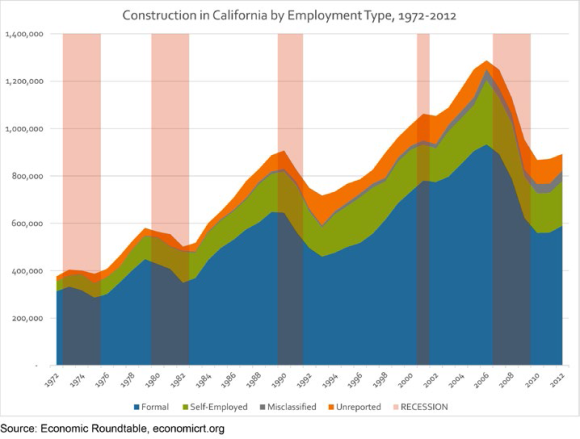A report by the nonprofit research group Economic Roundtable released over the Labor Day holiday found that one-in-six construction workers in California fell into the state’s “informal economy,” costing the workers’ compensation market $264 million among other hits to the federal and state governments.
This informal economy was comprised of 104,100 construction workers who were not reported by their employers and 39,800 who were misclassified as independent contractors in 2011, according to the report, titled “Sinking Underground: The Growing Informal Economy in California Construction.”
Construction is a $152 billion industry in California, employing 895,000 workers.

Informal employment in California construction has risen 400 percent since 1972, and the ranks of the informal swell with each economic recession, according to the report, which shows that after the most recent recession a larger share of workers have stayed in the informal sector because formal sector jobs have not been recovered — four years after the end of the last recession the industry has recovered only 66 percent of the jobs lost in the formal sector.
“Economic recessions increase the number of informally employed workers, as formal sector workers turn to the underground economy for jobs,” the report states.
The Economic Roundtable estimates that the informal tax gap was more than $774 million in 2011.
The federal government lost $301 million in taxes and California lost a total of $473 million, including $264 million for workers’ compensation, $146 million for state disability, and $63 million for state unemployment insurance, the report states.
“It’s a very big hit,” said Yvonne Yen Liu, one of the report’s authors.
She was referring to the workers’ comp loss, which also takes a human toll.
When workers are paid cash or are paid off the books, those employer are not paying into public revenues like Social Security, Medicare, unemployment insurance and the government is not receiving taxes, she said.
“And the uninsured workers, often times they don’t get adequate healthcare coverage,” she added.
The report cites as an example the case of Valentin Perez, who worked for drywall contractor Drywall Dynamics.
Perez suffered a herniated disk injury on a job hanging drywall on a construction site. However the employer refused to submit a claim for Perez under its workers’ comp policy, Liu said.
After several weeks of urging by Perez, the employer agreed to add him to its worker’s comp records, and then the employer misreported the date of the injury, she said.
The California Department of Insurance later found the owner guilty of insurance fraud, and the owner was also found guilty of wage theft.
Liu said there’s a need to make more of an effort to call out bad actors.
“There’s a need to really publicize these bad, wrongdoers,” she said. “It’s not just a few bad apples, it’s systemic across the industry.”
Construction workers like Perez who are informally employed also tend to earn less than those in the formal sector. For every dollar earned by a construction worker employed in California’s formal sector, an unreported worker makes 52-cents and a misclassified worker 62-cents, according to the report.
The report’s recommendations include: collaborative efforts to enforce labor, tax, employment, license and payroll laws; seeking legislative or regulatory reforms; conducting media campaigns to expose violators; establishing a wage floor so informal workers are paid at the same level as those in the formal sector; and expanding policy initiatives that support “high-road” contractors that do not under report or misclassify workers.
“A high-road labor index should be created based on the company’s labor practices and compliance with labor law,” the report states. “The rating system could be used by consumers and by public procurement agencies to select contractors who have sustainable employment practices.”
Topics California Workers' Compensation Construction Contractors
Was this article valuable?
Here are more articles you may enjoy.



 Disney Worker Injured Trying to Stop Runaway Boulder at Indiana Jones Show
Disney Worker Injured Trying to Stop Runaway Boulder at Indiana Jones Show  Berkshire Hathaway Raises New CEO Abel’s Salary to $25 Million
Berkshire Hathaway Raises New CEO Abel’s Salary to $25 Million  AIG’s Zaffino to Step Down as CEO as Aon’s Andersen Steps In
AIG’s Zaffino to Step Down as CEO as Aon’s Andersen Steps In  ’60 Minutes’ Homeowners Ask Court to Force DFS to Divulge Heritage Probe Info
’60 Minutes’ Homeowners Ask Court to Force DFS to Divulge Heritage Probe Info 


